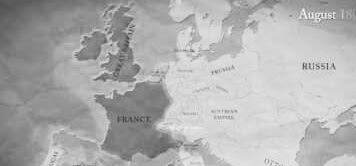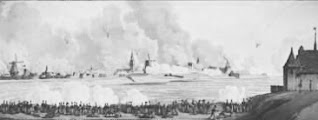Napoleon’s Invasion of Russia 1812 : Life History
Napoleon’s Invasion of Russia 1812 : Life History
 |
| Napoleon Bonaparte |
Napoleon’s Invasion of Russia Russia, 1812. Napoleon invades his former ally with thelargest army Europe has ever seen. But for the French Emperor, the decisive blowremains frustratingly beyond reach. Russia’s resilience is unlike anything he’sever encountered. And as winter closes in, his army begins themost infamous retreat in history. In 1807, following his defeat of the Russian army at Friedland, Napoleon had travelled to Tilsit to meet the Russian Emperor, Alexander. During their celebrated encounter, the twoemperors formed a friendship, and made an alliance. But it was not to last… Over the next five years, relations between France and Russia cooled dramatically.
 |
| Anna Pavlovna |
ruled by Alexander’s sister’s father-in-law.
Worst of all, was the fallout over ‘theContinental System’, Napoleon’s not very effective economic blockade against Britain,designed to cripple his most steadfast enemy. Alexander had agreed to join the Continental System at Tilsit, but it was hugely unpopular in Russia, and ruinous to her finances duringa period of economic crisis. When Napoleon found out that Russia was floutingthe rules of the System, and had resumed an illicit trade with Britain, he was furious. With both emperors accusing the other of badfaith, their two countries began preparing for war.
Napoleon knew an invasion of Russia was amassive undertaking – especially as he still had an unfinished war in Spain, that was tyingdown more than 200,000 troops. Never theless in 1811 he began to assemblethe largest army Europe had ever seen… Around 600,000 men… though less than halfof them were French. The rest came from allied states across Europe. There was a Polish corps from the Dutchy of Warsaw, led by Prince Poniatowksi, a corps from each of the German Kingdoms of Saxony,Westphalia and Bavaria, from the Kingdom of Italy, as well as Swiss, Dutch, Croat, Spanishand Portuguese units scattered throughout the army. There were even contingents from Prussia andAustria – France’s recent enemies, now uneasy allies. Some of these allied troops, such as the Polesand Germans, were as reliable as their French counterparts.
Others were very inexperienced, or like the Prussians and Austrians – reluctant to be there at all. This gigantic formation was deployed in threearmies, the main force under Napoleon himself, another led by his stepson Eugène, Viceroyof Italy, and a third led by his younger brother Jérôme, King of Westphalia.
Neither of these two were experienced commanders,though one would distinguish himself on campaign… the other would not. On their left flank Marshal Macdonald ledTenth Corps, with a large Prussian contingent… While the right flank was guarded by GeneralSchwarzenberg’s Austrian Corps.
Another 100,000 troops were in reserve, includingMarshal Victor’s Ninth Corps. Initially the Russians only had 220,000 mento face this juggernaut, organised into Barclay de Tolly’s First Army;Prince Bagration’s Second Army; and General Tormasov’s Third Army. They would be outnumbered two-to-one. But in the run-up to war, Russia scored twocrucial diplomatic triumphs: Sweden had been at war with Russia just threeyears earlier, a conflict which cost her Finland. By a curious turn of events, Sweden was nowruled by Napoleon’s ex-marshal, Bernadotte. But after Napoleon occupied Swedish Pomeraniawithout warning, a furious Bernadotte promised Russia that Sweden would remain neutral.
Stung by the Emperor’s criticism, humiliatedwhen his troops were put under Marshal Davout’s command, he resigned his post and returnedto Westphalia. The campaign was already beginning to exposeserious flaws in Napoleon’s plan. Knowing his troops would struggle to liveoff the land in this impoverished region, he’d organised huge supply depots and transportunits to feed the army. But wagons rolled slowly along Russia’sbad roads, which were turned to rivers of mud by summer thunderstorms.
The army had to make frequent stops to allowits supplies to catch up – bad news for Napoleon’s plan to catch the Russians, buta much-needed relief for the many thousands of young conscripts in his army, not usedto hard marches day after day. Many were soon dropping out with exhaustion;others deserted. There were also huge problems of command andcontrol, over a vast, multi-national army that was three times bigger than any Napoleon had commanded before. La Grande Armée, once famed for its speedof manoeuvre, had become a lumbering beast. After a pause to rest and regroup at Vilnius,Napoleon resumed his advance. Barclay continued his retreat to Vitebsk,where he hoped Bagration’s Second Army would be able to join him. But Davout blocked Bagration’s path at Saltanovka,forcing him to make for Smolensk instead.
At Vitebsk, Napoleon clashed with Barclay’srearguard, but once more the Russians escaped, after setting fire to all the stores theycouldn’t take with them. Meanwhile, 300 miles away, on Napoleon’ssouthern flank, Russian Third Army attacked and defeated the Saxon Seventh Corps, forcing Napoleon to divert Schwarzenberg’s Austrian corps to their aid. By the end of July, Napoleon had advanced250 miles into Russia – much further than he’d planned. And the long marches in extreme, summer heatcontinued to take a heavy toll on his men. Without fighting a major battle, the armyhad already suffered 20% casualties - from exhaustion and illness, particularly typhusand dysentery.
The army had entered Russia with quarter ofa million horses, but they were now dying at a rate of a thousand every day, from exhaustionand lack of fodder. It wasn’t just cavalry horses that weredying, but the very horses that were supposed to haul the army’s transport wagons, makinga bad situation worse. This crisis in horsepower came just as the French light cavalry, Napoleon’s eyes and ears, met their match… in Russia’s Cossacks. Cossacks – self-reliant, proud, ruthless,and superb horseman - didn’t play by the same rules as other European cavalry.
Every day they shadowed Napoleon’s army,swooping in whenever they saw an easy target, but melting away into the forests if theywere attacked by a stronger force. Cossacks, as well as Russian partisans, madehit and run attacks on French supply lines and depots, forcing Napoleon to divert thousandsof troops to their defence. Alongside Russian regular light cavalry, theyalso prevented French patrols from carrying out reconnaissance, which meant that Napoleono ften lacked good information about roads, or the enemy’s whereabouts. Napoleon stayed 16 days at Vitebsk, restinghis troops and considering his options.
Among his many mounting concerns was the securityof his long, exposed flanks. But at Vitebsk he received news that Schwarzenberghad defeated the Russians at Gorodeczna… A week later at Polotsk, a French-Bavarianforce fought Wittgenstein’s Russian First Corps to a standstill. Napoleon’s flanks were secure, for now. Although his main force had been reduced toless than half its original strength, Napoleon decided to push on to Smolensk, and try toforce the Russians into a decisive battle for the city. Barclay was indeed under pressure to givebattle, from fellow commander Prince Bagration and Emperor Alexander in St.Petersburg: thearmy’s morale and Russia’s honour required it, they told him.
With the First and Second Russian Armies finallylinking up near Smolensk, Barclay decided to attack Napoleon’s army, which he believedwas concentrated around Rudnya. The offensive was led by General Platov’sCossacks, who surprised a French cavalry division at Inkovo. But alarmed by false reports that Eugène’s Fourth Corps was out flanking him to the north, Barclay called off the attack. Napoleon, reassured that Barclay’s offensiveposed no real threat, began a grand outflan king move to the south, to take Smolensk and cutoff the Russian retreat. The so-called ‘Smolensk Manoeuvre’ was Napoleon at his best. Using Murat’s cavalry to screen his movementsand keep Barclay in the dark, the Emperor reached the Dnieper on the evening of 13th August. His engineers quickly threw up four pontoonbridges, and by dawn the next day, his army was across. Marshal Davout led a second column acrossthe river at Orsha.
But a single Russian division, the 27th , foughta heroic fighting retreat from Krasny, delaying the French advance… and buying time forBagration to reinforce the Smolensk garrison. The chance for a surprise assault on the citywas lost. And as the Russian army began to pull back,Napoleon displayed an uncharacteristic lack of urgency, even halting the army for a paradeto mark his 43rd birthday. When the main attack on Smolensk began twodays later, Napoleon opted for a frontal assault. 150 French guns battered the city, as three French corps attacked its medieval fortifications.
The Russians resisted bravely. But Barclay, fearing encirclement, orderedanother retreat. With Smolensk in flames, the Russians beganto pull out… just as the French fought their way into the city, to scenes of utter devastation. Bagration’s Second Army withdrew first… As Barclay’s army followed, its rearguardwas caught by Ney’s Third Corps at Valutino… General Junot, commanding the WestphalianEighth Corps, had orders to cut off Barclay’s retreat - but having crossed the river, hedid nothing, and the opportunity was lost. A furious Napoleon swore that Junot wouldnever now win his Marshal’s baton. The Battle of Smolensk cost both sides around10,000 casualties, and destroyed one of Russia’s most historic and holy cities – but settlednothing.
After the missed chance to defeat the Russia nsat Smolensk, Napoleon paused once more to consider his options. His men were weary and far from home, andit was already late in the campaigning season. He considered sitting out the Russian winterat Smolensk, and resuming the campaign in 1813. But now he was just 230 miles from Moscow. A century earlier, Peter the Great had moved Russia’s capital to St.Petersburg, but Moscow remained its historic and spiritual heart– a prize for which the Russians had to fight. Napoleon, always a gambler, decided to pushon. The Russians faced their own dilemma. Emperor Alexander had experienced a kind ofreligious epiphany that summer, and rallied the Russian people to the country’s defence,describing the war with Napoleon as a war to save Holy Mother Russia from the Antichrist.
For months the Emperor had received conflictingadvice – to stand and fight, or retreat. Now he decided change was needed. The cautious General Barclay kept his job,but the Emperor summoned General Mikhail Kutuzov to take overall command of Russia’s armies. Kutuzov had been beaten by Napoleon at Austerlitzseven years before, but he’d since won several victories against the Ottoman Empire, andwas a ‘true Russian’, loved by the troops. Although Kutuzov agreed with Barclay’s strategyof delay, he saw that constant retreats were destroying the soldiers’ and the nation’smorale. If Moscow was given up without a battle, thefallout could be disastrous.
And so, 70 miles west of the city, near thevillage of Borodino, the Russian army prepared to make a stand. Europe was about to witness the bloodiestday’s fighting of the Napoleonic Wars. Thank you to all our Patreon supporters formaking this series possible. Visit our Patreon page to find out how youtoo can support the channel, get exclusive updates, ad-free early access and help usto choose future topics. And did you know we have a new range of Napoleon-themedmerch for sale – click the merch shelf below or follow the links to find out more.
Napoleon Endgame: France 1814 :Life History
..........................Life History.........................










No comments: